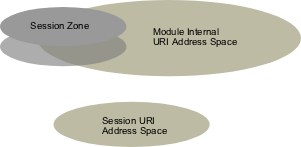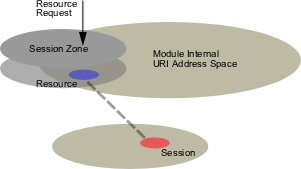HTTP is a stateless protocol used in the World-Wide-Web.
In HTTP all requests to a server are independent of each other.
This approach works very well for general information access
and for applications that follow the REST architectural style.
However,
there are architectural designs which are impossible without
session state maintained between a browser and a server.
is a stateless protocol used in the World-Wide-Web.
In HTTP all requests to a server are independent of each other.
This approach works very well for general information access
and for applications that follow the REST architectural style.
However,
there are architectural designs which are impossible without
session state maintained between a browser and a server.
Netscape developed
HTTP Cookies to support a mechanism to add state tracking to the HTTP protocol.
Cookies are simply a small amount of data that are stored
in the browser and returned to the server with each request.
Cookies are used either to store a session key
or a very small amount of session data within the browser client.
to support a mechanism to add state tracking to the HTTP protocol.
Cookies are simply a small amount of data that are stored
in the browser and returned to the server with each request.
Cookies are used either to store a session key
or a very small amount of session data within the browser client.
In Java J2EE, Servlets can support a session between the browser and the
server by using
either URL re-writing or the HTTP Cookie mechanism.
A J2EE container transparently tracks session state and
provides the programmer with a session context to access that state.
A programmer may store information such as
shopping cart contents in a J2EE Session
context.
HTTP Sessions
In NetKernel the
ext-session
module provides a session management framework.
Like the J2EE Servlet Session it provides the illusion of a stateful HTTP
protocol.
The
ext-session
module has two parts, the
session mapper
and the
session manager.
The session mapper uses the Cookie mechanism and works with the
session manager to provide a capability similar to the J2EE Servlet Session
context.
Because the session manager is distinct from the session mapper in NetKernel,
the session manager may be used in any application, independently of
the HTTP protocol.
We have
already seen
how ext-session provides URI based sessions
and how they can be managed with the provided services.
It is also useful to automatically maintain a session.
ext-session provides the
Session Mapper
accessor that
performs automatic session
creation and cookie based session affinity for
regions of a module's URI address space called zones.
Below is a diagram of a module URI address space and the session URI address space managed by the session data
accessor. A
session zone is a transparent layer over the module address space.

All requests for resources which are in the session zone will
be automatically reconnected to their session.
If the session does not exist a new session will be created for that request.

Module Configuration
To use the automatic session facility a module maps all
requests to the session mapper using a simple URI rewrite rule
and provides the mapper with configuration information
defining the various zones.
Note: in the rewrite rule the $e1 is important as it indicates
that the URI to be mapped to a session is escaped.
<rule>
<match>(.*)</match>
<to>active:sessionmapper+uri@$e1</to>
</rule>
With this rewrite mapping rule in place, the
session mapper will receive all requests and
use its configuration information to match
the requests against defined session zones.
Session mapper zones are configured in the resource
ffcpl:/etc/SessionPolicy.xml
document.
Below is a single zone which creates a session zone for all
requests in the
.*/mypath/.*
URI address space.
<SessionPolicy>
<zone>
<match>.*/mypath/.*</match>
<token>cookie</token>
<path>/mypath/</path>
<type>
<simple />
</type>
</zone>
<meta>
<id>SomeIdentifier</id>
<max-sessions>10</max-sessions>
<max-duration>60000</max-duration>
<min-duration>30000</min-duration>
</meta>
</SessionPolicy>
-
match
is a regular expression applied to the URI of the request.
-
token
is the type of the external session token to use. Currently only cookie is supported.
-
path
is the path that will be set on the cookie. This should match the external public address space of the web
request that will be handled by this module. Usually it is sufficient to make this path the same as the
match path.
-
type
contains settings for the session type to create. Currently only
simple
is supported.
-
id
a unique identifier for this session policy [default "DefaultPolicy"]
-
max-sessions
the maximum number of sessions to permit. [default 50]
-
max-duration
the maximum age that a session may have. [default 300,000 milliseconds]
-
min-duration
the minimum age before a session is at risk of being culled by new sessions.[default 30,000 milliseconds]
If a request URI matches the regular expression then it will be reconnected with its session.
If a request URI does not match the regular expression then it is reissued without modification - making
the mapper completely transparent for non-matching cases.
HTTP Cookies
The sessionmapper requires that your HTTPBridge be configured to pass cookies - please see theguide .
.
Example
Suppose that a session mapper is configured with the above example zone definition
and a request is received for the URI
active:dpml+operand@ffcpl:/mypath/myprocess.idoc.
The session mapper tries to match the request URI against it's defined session zone policy. Since the request
contains
/mypath/
it matches our example request.
The session mapper uses a value in the cookie passed with the request to reconnect to the session URI.
If no cookie is found a new session is created.
Finally the session mapper reissues the original request with the session URI attached.
active:dpml+operand@ffcpl:/mypath/myprocess.idoc+session@session1234567890123456
Once the request issued by the session mapper is completed
the session mapper automatically and transparently attaches a
session cookie to the response before it is passed back to the requestor.
Any subsequent external request in the session will include the cookie on the request.
The session mapper strips the external cookie session token, reconnects to
the session and exchanges the cookie for the internal session URI.
If expired, a new session is created.
Using Sessions in DPML
If a request in a session zone runs a DPML program the session URI can be access with:
this:param:session
within the DPML program.
This reference can be used just like the var:session URI examples shown in the first section.